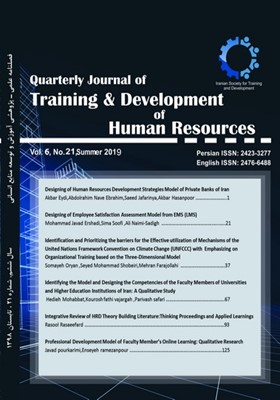Identification and Prioritizing the barriers to effective utilization of Mechanisms of United Nations Framework Convention on Climate Change (UNFCCC) by Emphasizing on organizational training based on the Three-Dimensional Model
Subject Areas :Somayeh Oryan 1 , Seyed Mohammad Shobeiri 2 * , Mehran Farajollahi 3
1 -
2 -
3 -
Keywords: Organizational Pathology, Environmental Education, Climate Change, Barrier’s analysis, Interpretive structural modeling,
Abstract :
This study aimed at investigating and prioritizing the pathology of organizational training on financial and non-financial mechanisms of United Nations Framework Convention on Climate Change (UNFCCC) by a diagnostic trichotomy model. This study was exploratory research and its methodology was developmental and applied research method. In terms of data collection was combined (quantitative and qualitative) research. The review documents and semi-structured interviews were used as data collection tools. In order to analyze the data, the content analysis for classifying method was used and interviews were conducted with 40 elite and specialists, who were selected purposefully. At the first stage, After extracting 212 barriers and removing repeated elements, 44 relevant concepts and contents classified into one of the three (structural, behavioral, environmental/context) dimensions of the model as a questionnaire. Through Lawshe content validity, 36 barriers were selected and reliability by 0.812 Cronbach coefficient alpha were confirmed. Thereafter, this obstacles were prioritized by Fuzzy Delphi method. At the third stage, it was examined how each barriers related legal, economic, political, administrative and environmental conditions influenced each other’s through ISM and MICMAC techniques. The results demonstrated that after international and national laws and legal issues, educational process was second effective item. Need assessment for different levels and stakeholders, lack of instructors familiar with the subject and lack of appropriate educational contents as the priority issues had been recognized.
Seif A. Educational Psychology.2002.Tehran: Payam Noor University Publication.
2- Abtahi H. Training and Development of Human Capitals. 2004. Tehran: Pooyand
Publication. 3- Babazadeh A, Ghahremani M. Akbari, M. Learning Organization as a foundation for Environmental Education. Journal of Environmental Education and Sustainable Development.2013. (2):69-78
4- UNCED. Agenda 21 and United Nations Conference on Environment and Development 1992.New York:UN.
5- Frantz C M, Mayer F.S. The importance of connection to nature in assessing environmental education programs. Evaluating Environmental Education.2014; (41): 85–89.
6- Mohanty S, Mohanty B. Global Climate change: a cause of concern. National Academy Science Letters.2009; 32(5):149–156.
7- Hamilton L.C. Education, politics and opinions about climate change evidence for interaction effects. Climatic Change.2011; 104 (2): 231-242.
8- Michaelowa, A..Determination of baselines and additionality for the CDM: A crucial element of credibility of the climate regime, in Yamin, F. (ed.), Climate change and carbon markets – A
handbook of emissions reduction mechanisms. 2005. London: Earthscan. 9- Schipper E L. Conceptual History of Adaptation in the UNFCCC Process .2006; 15(1(: 82-92.
10- Rahman S M. Kirkman G A. Costs of certified emission reduc-tions under the Clean Development Mechanism of the Kyoto Protocol. Energy Economics.2015; (47(:129–141.
11- UNFCCC. A Guide to the UNFCCC and its Processes. 2017. Available at
http://bigpicture.unfccc.int/content/mitigation.html. 12- Iran’s Department of Environment. Intended Nationally Determined Contribution.
2015. UNFCCC. Available at: http://www.unfccc.int/submissions/INDC/Published%20Documents/Iran/1/INDC%20Iran%20Final%20Text.pdf.
13- Department of Environment. Third National Communication to United Nations Framework Convention on Climate Change. 2017. Tehran: Department of Environment, 2017. #3Available at http://climate-change.ir/%D9%81%D8%A7%D8%B1%D8%B3%DB%8C_2234.html 14- The Expediency Discernment Council. Islamic Republic of Iran’s Environmental Policies.2016. Available at http://81.91.157.27/DocLib2/
15- UNFCCC. CDM Insights.2018. retrieved from: http://cdm.unfccc.int/Statistics/Public/index.html/7 pm, Jan 31,2018.
16- National Climate Change office of Iran’s Department of Environment,Joint Implementation Mechanism. 2017. Available at http://climate-change.ir -(JCM)_2202.html
17- UNEP Risoe. Understanding the Concept of Nationally Appropriate Mitigation Action, 2013. Denmark: UNEP Risø Centre.
18- ECOFYS. NAMA Database.2018. Retrieved from: http://www.nama-database.org/index.php/Main_Page10pm, Nov 12, 2018.
19- GCF. GCF Handbook: Decisions, Policies, and Frameworks. 2018. retrieved from: https://www.greenclimate.fund/documents/20182/296788/GCF_Handbook__Decisions__Pol
icies_and_Frameworks__updated_April_2018_.pdf/ 20- GCF. The latest information of climate funds.2018. Retrieved from10pm, Oct 29, 2018.
21- UNFCCC. Adaptation Fund. 2018. Retrieved from http://unfccc.int/cooperation_and_support/financial_mechanism/adaptation_fund/items/365
9.php12pm, Feb 29, 2018. 22- Agrawala S. Carraro M. Kingsmill N. Lanzi E. Mullan M. Prudent R G. Private Sector
Engagement in Adaptation to Climate Change: Approaches to Managing Climate Risks.2011. OECD Environment Working Papers (39). OECD Publishing. 23- AF.Adaptation Fund Projects .2018. retrieved fromhttps://www.adaptation-
fund.org/projects-programmes/11pm, March 23,2018 24- GEF. GEF Projects and Funding.2018. retrieved from
https://www.thegef.org/gef/gef_projects_funding 11pm, Feb18,2018 25- UNEP. The Climate Technology Centre and Network (CTCN).2018. retrieved
from:http://www.unep.org/climatechange/ctcn 26- UNFCCC. Capacity Building.2018. retrieved from https://unfccc.int/topics/capacity-#3building/workstreams/capacity-building-portal 27- Iran’s department of Environment. National strategic Plan on Climate #3Change.2017.Tehran: Hak Publication. 28- Nasseri M .Ahadi M.S. Assessment of the Islamic Republic of Iran's Policy on Climate
Change. Strategy socio-cultural.2017; 5(21): 23-50.
29- Fathi Vajarghah K. In service Training Planning.2011.Tehran:Samt Publication. 30- Shams mourkani G, Safayi Nasab M. Fatemi Sefat A. Studying the Challenges of Training and Development of Human Resources Based on Three Branches Model, CaseStudy:Fajr
Insustry), Journal of Training and Development of Human Resources.2016; (7):75-100. 31- Mobini Dehkordi A. Keshtkar Haranaki M. Analyzing the Effects of Three-Dimensional Model on Social Innovation: A Case Study of a Company in Iran's Automotive Industry.
Innovation Management Journal. 2015; 3 (4):57-75. 32- Mirzaee H. Sarlak M.A. Organizational Epistemology: The Evolution of Doctrine and
Management Applications, Peik Paeez Journal.2005; (11):69-78. 33- Linstone H. A. Turoff M. The Delphi Method: Techniques and Applications.2002. NJ:
New Jersey Institute of Technology. 34- David W.M. An Introduction to the Application of interpretive Structural Modelling”.
Proceedings of the IEEE, 1975; 63(3) 397-404. 35- Rajesh A. Nikhil D. Vivek S. Interpretive Structural Modelling (ISM) approach: An
Overview. Research Journal of Management Sciences. 2013; (2): 3-8. 36- Firuzjaeyan A. Firuzjaeyan M. Hashemi Petroodi H. Gholamrezazadeh F . Applying Techniques of Interpretive Structural Modeling (ISM) in Tourism Studies (A Pathological Approach). Tourism Planning and Development Magazine.2013; (6):129-159.
37- Atashsouz A. Feyzi K. Kazazi A. Olfat L. Interpretive structural modeling for relationships between risks in the supply chain of the petrochemical industry in Iran. Industrial Management
Journal.2015; (14):39-63.

